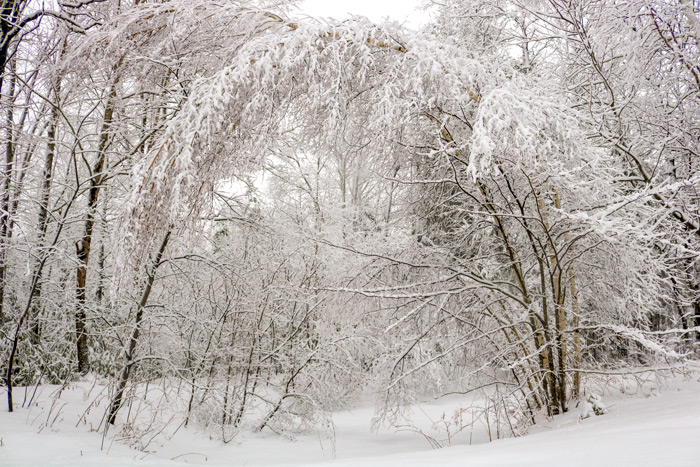
As Maryland experiences yet another snow storm this frosty winter, take the time to consider the amazing science behind how trees manage the constant onslaught of rain, ice, and snow.
Each tree species has their own special method of winter survival. For deciduous trees, this process starts when they first shed their leaves in fall. Less leaves means less surface area for snow and ice to collect, reducing the overall weight the tree has to bear. Oaks and sugar maples are especially resilient, with their large and heavy branches that remain steadfast in poor weather. Non-native tree species, like the European Beech, have a shallow root structure that is more susceptible to uprooting when laden with snow. Conifers, of course, do not lose their needles over winter. Instead, their pointy needles and conical shape are adapted to let snow slide off, and allow the tree’s branches to bounce back to their normal position.
These bendy branches were the focus of a recent Stanford and University of Alaska study. Researchers found that trees and shrubs from colder environments had branches that bent further in colder weather than warmer weather. This finding is counterintuitive to traditional knowledge, as biological materials like tree branches are thought to become more brittle and stiff in colder temperatures. The researchers named this phenomenon cryocampsis. It is most prevalent in arctic and boreal biomes, but a number of tree species in temperate biomes displayed the same tendencies. Cryocampsis involves the collapsing of a branch’s xylem cells at sub-freezing temperatures. Xylem cells are responsible for transporting water and minerals from a plant’s roots to its leaves, and play a large role in trees’ structural stability. Plants that undergo cryocampsis can selectively dehydrate xylem cells on the top and bottom of branches, allowing for unusual levels of stretching and compression. This process results in ultra-flexible branches that can withstand significant amounts of snow without breaking.
Cryocampsis is yet another example of trees’ amazing yet unseen phenomena. Next time you step out into a snowy forest, take the time to consider the bowing but resolute branches. Who knows, maybe you’re watching cryocampsis in action.
References (in order of appearance)
https://glaszart.com/our-first-big-snowstorm-of-the-year/
https://www.forestsociety.org/something-wild/bend-dont-break-how-trees-survive-norther n-winters
https://www.phipps.conservatory.org/blog/detail/biopgh-blog-conifers-in-the-cold#:~:text =Needles%20minimize%20the%20weight%20of,can%20handle%20harsh%20winter%2 0winds.
https://academic.oup.com/pnasnexus/article/1/4/pgac131/6649659
